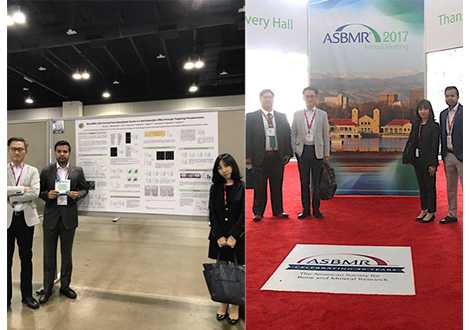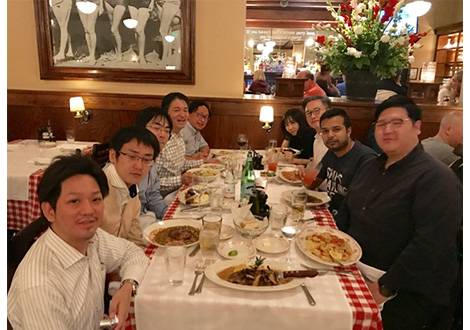
骨ルポ
ASBMR 2017 レポート
Faisal Ahmed(広島大学大学院歯学部硬組織代謝生物学)

It was my first time as a presenter on ASBMR 2017 and also as an attendee. And my poster presentation was selected for Plenary poster session, which was so appreciable for new researcher like me. I was so excited to attend this kind big International Conference like ASBMR. I tried to grab new information and also increase my knowledge throughout the whole program. I am looking forward to attending and present our study on this kind of International Conference in future also.
紹介演題 [1]
The soluble form of RANKL contributes to cancellous bone remodeling in adult mice but is dispensable for ovariectomy-induced bone loss
キーワード
Osteoclast, RANKL, bone remodelling
研究グループ
Jinhu Xiong, Keisha Cawley, Marilina Piemontese, Yuko Fujiwara, Ryan Macleod, Joseph Goellner, Haibo Zhao, Charles Obrien
- University of Arkansas for Medical Sciences, United States
サマリー&コメント
RANKL is produced as an integral membrane protein but can be cleaved to produce a soluble form (sRANKL). Cell culture studies suggest that the membrane-bound form is required for osteoclast formation. However, transgenic mice over-expressing sRANKL or mice injected with sRANKL exhibit increased resorption. They tried to determine the relative importance of membrane-bound versus sRANKL by creating mice that produce only the membrane-bound form. To do this, we generated a series of RANKL constructs lacking increasing amounts of the extracellular stalk region, which contains all known cleavage sites, and tested their resistance to MMP14, a protease that exhibits potent RANKL sheddase activity. They used the CRISPR/Cas9 system to introduce this mutation into the endogenous RANKL gene (tnfsf11) in mice. Mice homozygous for this mutation, designated RANKLsr, displayed normal tooth eruption, lymphocyte numbers, and lymph node development. Soluble RANKL was completely undetectable by ELISA or Luminex assay in either blood or bone marrow plasma from RANKLsr mice, but was easily detected in these fluids from WT littermates. No differences were observed on analysis of bone mass and architecture by MCT. In Histology, they showed less number of osteoclast in cancellous bone of RANKLsr mice compared to WT littermates. In case of overiectomy they found almost same results as similar amounts of bone loss, and increased osteoclast number to a similar extent, in RANKLsr and WT mice. These results demonstrate that sRANKL contributes to osteoclast formation and bone remodeling in adult mice but not to the pathological bone resorption caused by estrogen deficiency.
For me this topic is so interesting, due to related to my research field. And now I am thinking to do make some different hypothesis for future research by using this valuable new finding.
紹介演題 [2]
ENPP1 Enzyme replacement prevents bone loss and corrects fracture susceptibility in a murine model of autosomal recessive hypophasphatemic rickets type 2
キーワード
ENPP1, GACI and ARHR2
研究グループ
Mark Horowitz, Dillon Kavanagh, Xiaofeng Li, Tracy Nelson, Steven Tommasini, Demetrios Braddock
- Yale University of School of Medicine, United States
サマリー&コメント
Humans with ENPP1 loss of function develop a rare disease called Generalized Arterial Calcification of Infancy (GACI), characterized by extensive and often life-threatening calcification of the large and medium sized arteries as well as soft tissues. If affected individuals reach the age of 6 months they are likely to survive but will invariable develop elevated FGF23 and a phosphate wasting rickets, an evolution of their disease known as Autosomal Hypophosphatemic Rickets type 2 (ARHR2). The bone disease in ARHR2 can be severe and symptomatic, leading to repeated fractures of the long bones, rachitic skeletal deformities and impaired growth and development. They recently described an enzyme replacement therapy (ERT) preventing vascular calcification and death in the GACI enpp1asj/asj mouse. To understand the effects of ERT on the skeletal abnormalities in the ARHR2 phase of the disease, they use enpp1asj/asjmice for injecting ENPP1-Fc. treatment with ENPP1-Fc ERT prevented the growth plate deficiency, trabecular and cortical bone loss and restored biomechanical strength and stiffness to that of controls measured by MCT and histology.
Their findings have important implications for the treatment of patients with ARHR2 and provide in vivo evidence of a role for ENPP1 in other bone loss diseases.

Dinner meeting of our team with Professor Atsushi Suzuki Sensei's team.





